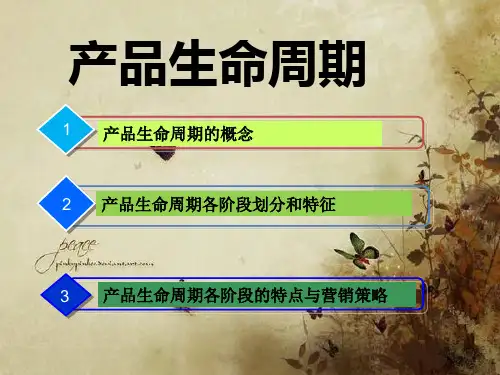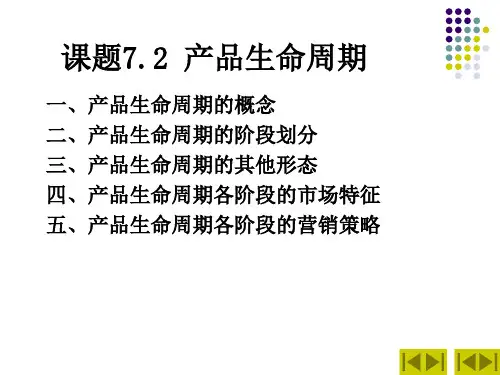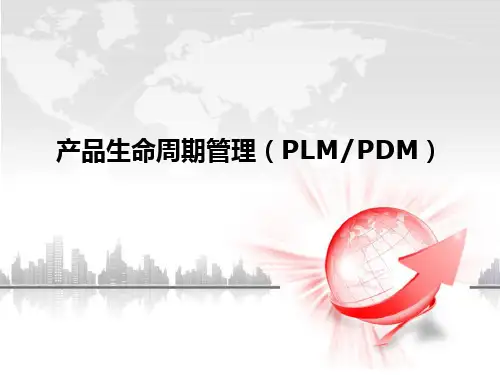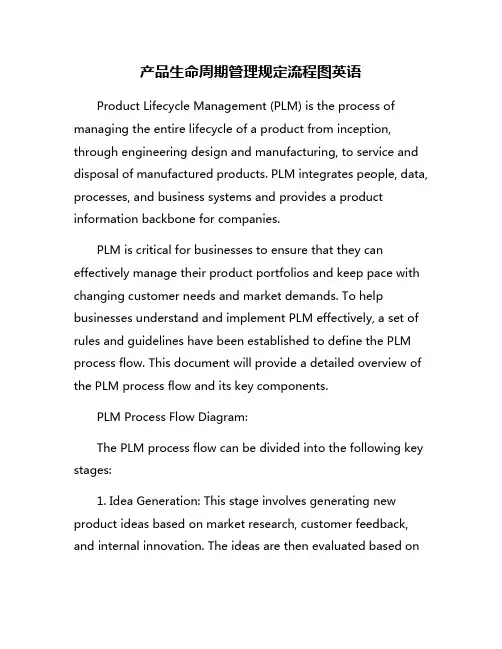产品生命周期英文版.ppt
- 格式:ppt
- 大小:1.08 MB
- 文档页数:17










产品生命周期管理规定流程图英语Product Lifecycle Management (PLM) is the process of managing the entire lifecycle of a product from inception, through engineering design and manufacturing, to service and disposal of manufactured products. PLM integrates people, data, processes, and business systems and provides a product information backbone for companies.PLM is critical for businesses to ensure that they can effectively manage their product portfolios and keep pace with changing customer needs and market demands. To help businesses understand and implement PLM effectively, a set of rules and guidelines have been established to define the PLM process flow. This document will provide a detailed overview of the PLM process flow and its key components.PLM Process Flow Diagram:The PLM process flow can be divided into the following key stages:1. Idea Generation: This stage involves generating new product ideas based on market research, customer feedback, and internal innovation. The ideas are then evaluated based ontheir feasibility, market potential, and alignment with the company's business goals.2. Concept Development: Once a viable product idea is identified, the concept development stage involves creating a detailed product concept that outlines the product's features, functionality, and design requirements.3. Design and Engineering: In this stage, the product concept is translated into a detailed design and engineering plan. This includes creating 2D and 3D models, conducting simulations and testing, and validating the design against specifications.4. Manufacturing: Once the product design is finalized, the manufacturing stage involves setting up production processes, sourcing materials, and manufacturing the product according to the design specifications.5. Quality Assurance: The quality assurance stage involves testing the manufactured product against quality standards to ensure that it meets customer expectations and regulatory requirements.6. Marketing and Sales: Once the product is manufactured and tested, the marketing and sales stage involves promotingthe product to target customers, conducting market research, and setting pricing and distribution strategies.7. Service and Support: The service and support stage involves providing post-sales support to customers, such as warranties, repairs, and product updates, to ensure customer satisfaction and loyalty.8. End-of-Life: The end-of-life stage involves planning for the disposal or recycling of the product once it reaches the end of its lifecycle. This includes implementing sustainability practices and complying with environmental regulations.Key Components of PLM Process Flow:1. Product Data Management (PDM): PDM involves managing product-related information, such as design files, specifications, and bill of materials, in a centralized system to ensure accurate and up-to-date product data.2. Configuration Management: Configuration management involves controlling changes to product designs, specifications, and components to maintain product consistency and integrity throughout the lifecycle.3. Change Management: Change management involves documenting, evaluating, and implementing changes to productdesigns, processes, and systems to ensure that they are effectively communicated and implemented.4. Collaboration and Communication: Collaboration and communication involve fostering teamwork and communication among cross-functional teams, such as design, engineering, manufacturing, and sales, to ensure that all stakeholders are aligned and informed throughout the PLM process.5. Workflow Automation: Workflow automation involves streamlining and automating key processes, such as product approvals, document reviews, and change requests, to improve efficiency and reduce errors in the PLM process.Conclusion:In conclusion, the PLM process flow is a comprehensive framework for managing the entire lifecycle of a product from ideation to disposal. By following the rules and guidelines outlined in this document, businesses can effectively implement PLM to develop innovative products, improve product quality, and enhance customer satisfaction. PLM is essential for businesses to stay competitive in today's rapidly changing market landscape and drive business growth and profitability.。
